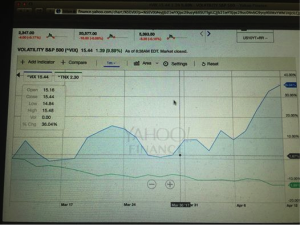It’s enough to make you close up shop and seek out a new career if you’re a portfolio or hedge fund manager. I say that tongue and cheek of course, but next week will prove to be quite interesting if you have been reading the headlines and/or listening to what the major media outlets have been cultivating If we take these events mentioned in order, the greatest consideration would likely produce a good deal of volatility in the markets next week. Leading up to the aforementioned market events, volatility had already been rising and before peaking out at roughly 16.25 recently.
What had been sparking higher levels of volatility/fear, as represented by the VIX, had been the unusual dive in the 10yr. U.S. Treasury yield. This may have been the markets way of addressing the mentioned events in advance. Despite the FOMC’s decision to raise rates, the 10yr has done little more than find lower yields.

Such an outcome hadn’t been expected by many economists, as the normal trend of long-dated treasury yields during a period of rising Prime rates has been to rise in accordance with the Prime rate. The chart above recognizes the almost absolute correlation between the 10yr Treasury yield and the VIX over a 2-week period for which yields fell from 2.37%-2.28% and as the VIX rose from 13-16. The correlation finally detached last week as the VIX dropped a bit, even as rates continued their path lower with the 10yr yield dipping below 2.20 percent.
Golden Capital Portfolio invests in VIX-leveraged ETF/ETNs and as the Chief Investment Officer and Market Strategist, I’m always on the hunt for VIX correlations; I almost have to be as these instruments bear little efficacy with regards to technical analysis. Inverse VIX-leveraged ETPs such as ProShares Ultra VIX Short-Term Futures ETF (UVXY), VelocityShares Daily 2x VIX Short-Term ETN (TVIX), iPath S&P 500 VIX Short-Term Futures ETN (VXX) and the like have an intrinsic or designed decay. The level of the ETP is based on the value of the VIX short-term futures contracts (“VIX futures contracts”) that comprise the ETP. While there is a relationship between the performance of the ETP and future levels of the VIX, the performance is not directly linked to the performance of the VIX, to the realized volatility of the S&P 500 or to the options that underlie the calculation of the VIX. When trading or investing in these instruments, it is important to understand this concept before doing so. Keeping in mind that these instruments have been active in the marketplace for less than a decade, and are extremely unique in their construct, much of their trading patterns and usage by investors/traders is still developing an understanding for practical analysis and usage. In other words, what we have come to understand thus far, may find a new or elevated understanding in the future.
Moreover, even some of the more commonly used terminology for understanding the variables that affect the likes of these instruments can be called into question for usage. Two such terms that are widely used and recently exhibited with regards to VIX-Leveraged instruments is contango and backwardation. Look, I don’t really desire to get into the whole “backwardation” definition discussion here, so let’s just say I’ll go along with the text book definition offered by Investopedia… even as I find it illogical and lacking a correlation to the root word “backward”. “Backwardation occurs when the futures price of a commodity is lower than its market price today. Backwardation does not happen very frequently, and when it does, it usually doesn’t last long.”
That’s the definition of backwardation as offered by Investopedia, Webster’s Dictionary and even coined in the ProShares S-1 of these instruments. Within that same regard, backwardation is the opposite of contango, again, as offered by Investopedia.
“When the market for these contracts is such that the prices are higher in the nearer months than in the more distant months, the sale during the course of the “rolling process” of the more nearby futures contract would take place at a price that is higher than the price of the more distant futures contract. This pattern of higher futures prices for shorter expiration futures contracts is referred to as “backwardation.”









Leave A Comment